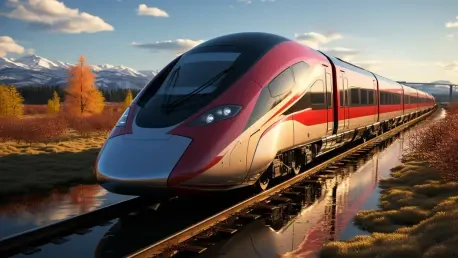Setting the Stage: The High-Stakes Game of Rail Modernization
In the heart of the United Kingdom, the HS2 railway project stands as a monumental endeavor, promising to redefine connectivity between major cities with unprecedented speed and efficiency. Yet, with costs spiraling and timelines stretching, the pressure is on to deliver value amid mounting challenges, making this a critical moment for innovation. This market analysis dives into how technological innovation, spearheaded by initiatives like the HS2 Innovation Accelerator Program, is becoming a key driver for transforming the rail infrastructure sector. By examining current trends, data-driven impacts, and future projections, this exploration sheds light on the evolving dynamics of high-speed rail development. The stakes are high—not just for HS2, but for the broader industry looking to balance efficiency, safety, and economic growth through cutting-edge solutions.
Decoding Market Trends: Technology as the Backbone of HS2
Innovation Accelerators Driving Sectoral Change
The rail infrastructure market is witnessing a seismic shift toward technology-driven solutions, with programs like the HS2 Innovation Accelerator, now in its eighth round, leading the charge. Launched in collaboration with Connected Places Catapult, this initiative has become a cornerstone for integrating small tech firms into large-scale projects. Since its inception, it has supported 37 companies, resulting in 31 pilot projects that have delivered measurable cost savings for HS2. This trend of partnering with agile startups reflects a broader industry move toward leveraging niche expertise to solve complex logistical puzzles, setting a precedent for how public-private collaborations can redefine infrastructure delivery.
Digital Tools Redefining Productivity Metrics
A dominant trend in the market is the adoption of digital tools to enhance productivity on construction sites. The latest round of the accelerator program focuses on solutions for improving site visibility and streamlining workflows, addressing inefficiencies that have long plagued mega-projects. Data from past rounds indicates that tech interventions have optimized resource allocation, cutting down delays significantly. As rail projects grow in complexity, the demand for scalable digital platforms is surging, with the market increasingly favoring solutions that can integrate seamlessly across diverse operational environments, signaling a robust growth area for tech providers.
Safety Tech: A Growing Investment Priority
Safety remains a critical concern in rail construction, driving investment in innovative technologies such as real-time monitoring systems and predictive analytics. The HS2 program actively seeks solutions to mitigate risks, with previous pilot projects demonstrating enhanced worker protection through digital safety protocols. Market analysis shows a rising appetite for fail-safe systems that can preempt hazards, though challenges persist in ensuring reliability under high-stakes conditions. This focus on safety tech not only addresses immediate project needs but also aligns with stricter regulatory standards, positioning it as a key growth segment for innovators in the rail sector.
Economic and Regional Ripples: Market Impacts of Tech Integration
Small Firms Fueling Economic Expansion
Beyond operational advancements, the economic implications of tech innovation in rail infrastructure are profound. The HS2 accelerator has catalyzed growth for small tech firms, with over 40% securing further contracts within the supply chain, raising more than 240 million GBP in funding, and creating over 580 jobs. This ripple effect underscores a market trend where supporting smaller players not only drives project efficiency but also stimulates broader economic vitality. As these firms double their workforce, the rail sector is becoming a significant contributor to job creation, reshaping local economies tied to infrastructure hubs.
Regional Connectivity and Market Opportunities
Regionally, HS2’s progress, including major milestones like the completion of the longest bridge and tunnel this year, is altering market dynamics by enhancing connectivity across the UK. This development opens up new opportunities for tech solutions tailored to diverse terrains and community needs, from urban centers to rural corridors. The market is responding with increased demand for localized innovations that address specific regional challenges, creating a niche for startups to capitalize on. This trend highlights how rail projects can act as catalysts for regional market expansion, drawing investment into previously underserved areas.
Funding and Policy Shaping Market Trajectories
Government backing and policy frameworks are pivotal in steering the rail tech market, particularly with an emphasis on green technologies and safety standards. Financial incentives for sustainable solutions are encouraging innovators to pivot toward eco-friendly systems, while regulatory pressures ensure that safety remains a top priority. Market projections suggest that over the next two years, from 2025 to 2027, funding for digital rail solutions could see a significant uptick, driven by public sector commitments to infrastructure modernization. This policy-driven momentum is likely to sustain growth in the tech-rail intersection, offering fertile ground for investment.
Future Projections: The Next Frontier in Rail Tech
Emerging Technologies on the Horizon
Looking ahead, the rail infrastructure market is poised for transformation through emerging technologies like artificial intelligence, the Internet of Things (IoT), and advanced data analytics. These tools promise to revolutionize construction and operational phases by enabling predictive maintenance and real-time decision-making. Industry forecasts indicate that within the next decade, integrated digital ecosystems will dominate rail projects, with HS2 serving as a testing ground for such innovations. The current accelerator round, with applications closing on October 31, aims to harness these trends by selecting six finalists for trial projects, potentially setting new benchmarks for efficiency.
Market Growth and Competitive Landscape
Market analysis projects a compound annual growth rate in rail tech investments as adoption accelerates across global projects inspired by HS2’s model. The competitive landscape is heating up, with small tech firms vying for a share of the pie alongside established players, driven by the promise of long-term contracts and scalability. Data suggests that firms participating in accelerator programs gain a competitive edge, often securing follow-on work that amplifies their market presence. This dynamic is expected to intensify competition while fostering a culture of continuous innovation within the sector.
Challenges and Opportunities in Scaling Solutions
Despite the optimism, scaling tech solutions across massive projects like HS2 remains a hurdle, with logistical complexities and integration challenges posing risks. However, these challenges also present opportunities for market differentiation, as firms that can offer adaptable, user-centric technologies are likely to lead. Projections indicate that overcoming these barriers will be crucial for sustaining market growth, with successful innovators potentially influencing standards across international rail markets. The balance between risk and reward in this space will shape the trajectory of tech adoption in infrastructure over the coming years.
Reflecting on the Path Forward: Strategic Insights from HS2’s Tech Journey
Looking back, the journey of integrating technology into HS2 through the Innovation Accelerator Program offers a transformative blueprint for the rail infrastructure market. The initiative proved that small tech firms could drive significant cost savings, enhance safety, and boost productivity, while also fueling economic growth through job creation and funding. Its impact reverberated beyond immediate project goals, influencing regional markets and setting a precedent for public-private collaboration. For stakeholders, the takeaway is clear: investing in scalable, innovative solutions is not just a necessity but a strategic advantage. Moving forward, the industry needs to prioritize accelerator models that empower smaller players, while policymakers must sustain funding for digital advancements. The challenge ahead lies in ensuring that these tech breakthroughs can scale globally, cementing HS2’s legacy as a pioneer in rail modernization.









